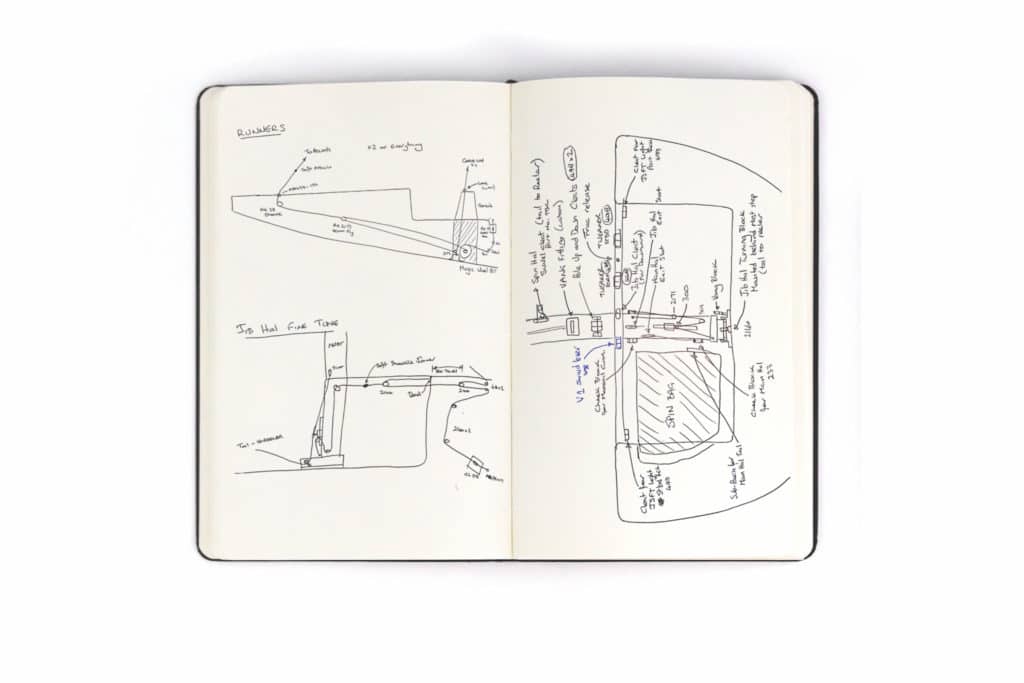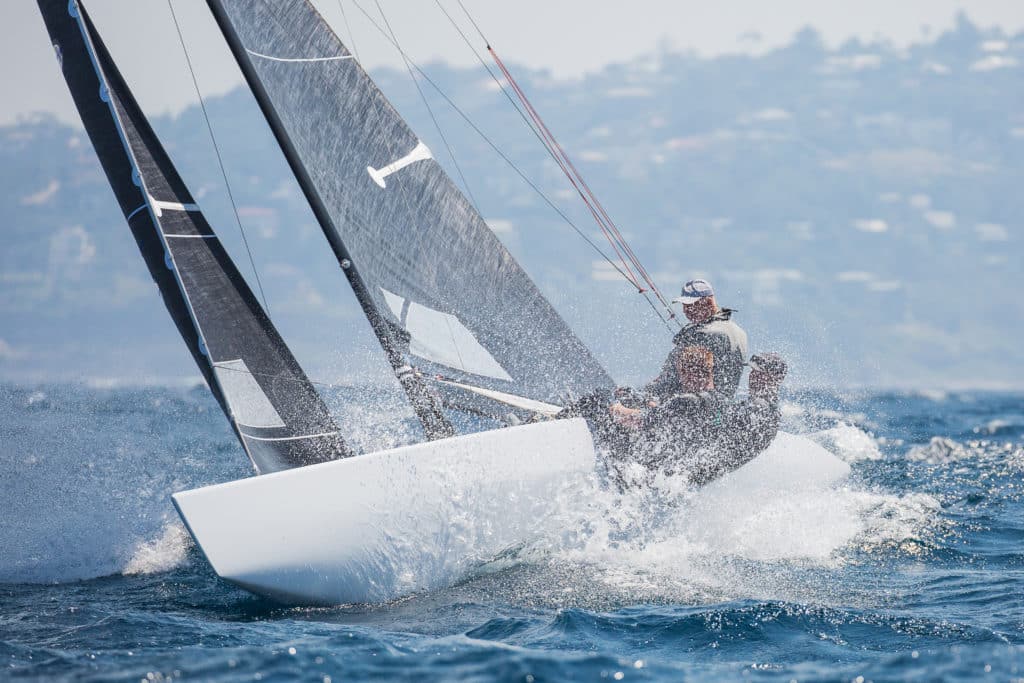
I had been speaking with Sailing World’s Dave Powlison about a potential series of articles highlighting the major generic controls on most keel-boats to control the rig and sails, when it suddenly occurred to both of us that we could do this series in parallel to my involvement in the creation of two 5.5 Metre class yacht builds taking place in Cowes, on the Isle of Wight in England.
Why the 5.5 as a platform for this discussion? For starters, there are no fewer than 46 control points. This is where a control line is directed to a crewmember. Believe me, I have “simplicity” going through my mind at every moment—we are doing all we can to minimize complication. At every step of the way, we debate what we do and don’t need and where it needs to be led.
What makes this such an interesting project is the “blank canvas” nature of the rig plan and deck layout. After a lifetime of working within the constraints of one-design rules, the 5.5 Metre is totally unrestricted when it comes to systems, layout and rig control. The class was conceived in 1949 as a measurement formula to provide level racing under a con-trolled rating rule that revolves around hull length, sail area and overall displacement, with limits on minimum and maximum sail area and displacement, among others.
Given the development nature of the class, I find it really interesting that, at the 2020 Worlds in Sydney, within the Modern fleet, we had boats of differing lengths, sail areas, displacements, append-age volume and geometries, and yet the racing was as tight as anything I had experienced in one-design classes. This speaks to how refined and optimized to the rating formula these boats are.
The 5.5 came into the world spotlight when it achieved Olympic status, starting with the 1952 Helsinki Games, and remained there for five quads, up through 1968. After the 1968 Games, the class was replaced by the less- expensive Soling, and the 5.5 earned the distinction of the last-ever development class used for Olympic competition.
What makes this such an interesting project is the “blank canvas” nature of the rig plan and deck layout. After a lifetime of working within the constraints of one-design rules, the 5.5 Metre is totally unrestricted when it comes to systems, layout and rig control.
Originally timber, the hulls in the 5.5 Modern fleet (any design since 1994) are con-structed with composites, but the construction rules restrict the panel weight. Consequently, the boats are very stiff and reliable. Likewise, the spars are now carbon fiber, but the mast has a minimum weight similar to the Etchells’ alloy mast. Hence the high-modulus masts of today are incredibly stiff and strong for the loads they carry.
In the past 20 years or so, Swiss boats designed by Sebastian Schmidt and built by Christof Wilke have dominated the class. As any Finn sailor can attest, Wilke’s craftsmanship is superb. These boats are pieces of art, with everything in beautiful proportions—a design that has stood the test of time. They really are “floating pianos,” refined and sophisticated but also perfectly tuned and simple to play. And like the piano, to play well, they demand a significant investment of time.
In 2010, at Lake Garda, Italy, I had the good fortune to team up with two great Swiss sailors who possessed a wealth of experience in the class and venue: Flavio Marazzi and the aforementioned Wilke, with me in the middle. We won that event. It was “one and done” for the next 10 years, before joining Brits Peter Morton and Andrew Mills in Sydney a year ago, which takes us to the here and now—Cowes—winter, and the scene of so many yacht-racing builds over so many decades.
Following the Sydney Worlds, Peter Morton (or Morty, as most people know him) caught the 5.5 Metre bug. In Sydney, we felt slightly outgunned in our 16-year-old Wilke boat, so discussions turned to producing a new boat, and Morty being Morty, it was always going to be built local to his home in Cowes.
As the pandemic lockdown took over our lives in spring 2020, David Hollom was com-missioned to design the boat. Hollom submitted a number of candidate shapes that were analyzed using CFD tools in Australia by Steve Quigley’s One2Three Naval Architecture firm. America’s Cup icon (and Morty’s close friend) Tom Schnackenberg assisted with the validation by applying VPP analysis to the hulls, using their sail areas and displacements. North Sails provided guidance on the rig and sail plan, and we were off and running.
Gavin Tappenden, of Composite Craft UK, was appointed to build the boat in Cowes, with Suzy Russell, of Orca Consulting, given responsibility for the construction design. The button was pushed in August 2020 for hull and deck plugs to be machined and molds taken from the plugs at Sinergia Racing Group in southern Spain.
At the same time, Morty was offered the deck, appendages, spars and associated hard-ware from another 5.5 Metre, one that did not set the world on fire from a performance perspective. Desiring to build the fleet locally and provide employment for the local raceboat-building industry in the grips of the pandemic, Morty also commissioned David Heritage and team to build the next-best design candidate.
With the “engine above the deck,” we took delivery of a lovely high-modulus carbon spar from Heol Composites in Brittany. It is super-stiff, so we have some decisions to make on standing- and running-rigging configurations, which are, again, unrestricted. More blank canvas!

My role in all of this is to ensure that everything works, it all fits together, and the crew can extract the best performance possible from these boats. Over the winter, I’ll chronicle how the various systems come together, as well as why we have them and how we are working to overcome obstacles that almost every-one encounters when creating or simply updating. I’ll be zeroing in on systems that are not just specific to the 5.5 but more generic.
The first item I’ll focus on is the mast step and its adjustability. Other areas will likely include the jib sheeting system, our “magic wheel” mechanical purchase system (in lieu of a traditional purchase system), adjustable mainsail tack, plus a discussion of the rig geometry and controlling stiffness with runner and deflector. Each part of the series will have a generic side to them so that you can see their effects and how they can be set up on different boats—perhaps even yours. But the series will also focus on the 5.5′s we are building and why we have elected to set them up in the way we have.
As we are slowly coming to realize, despite our hopes, 2021 might be another year with very limited traveling. Morty must have envisioned this—stretching out in front of us from April is some full-scale 5.5 Metre testing on the Solent waters with three boats. I’m sure it will be an interesting ride for us all!









